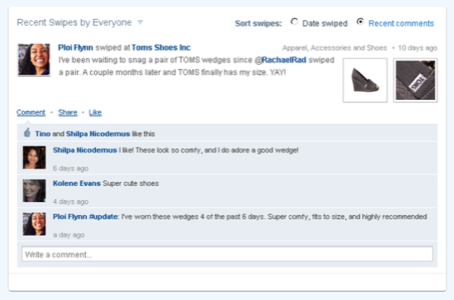The social shopping network Swipely, in private beta for three months, is opening up to the public today. Users upload credit and debit card information so the site seamlessly records where they’re “swiping,” then choose which purchases to broadcast to friends, with the option to add an image or comment.

Try to explain this idea to any of your non-techie friends, and you’ll probably get one reaction: ew, creepy.
Add in Swipely’s focus on geolocation, and you have a recipe for scaring people off.
Swipely founder Angus Davis acknowledged the challenge. But he said Swipely had twice as many inquiries as it had beta invites, the thousands of users who did get invites love the service, and besides, the company isn’t focused on drafting users right now. It’s working on user experience and added value, Davis said, and will attract users over time.
A screenshot from Swipely yesterday.

The ultimate goal is to connect the offline world, where people do most of their spending, with the online world, where they do most of their talking about their spending. People spend most of their money offline but most online marketing pushes users toward an online purchase, Davis said – “Big disconnect.”
How it works
Swipely collects purchase information from more than 4,000 banks and credit card companies, using the Localeze database to match transaction codes to physical locations. Users can also forward email receipts to Swipely or install a Gmail plugin that pulls receipt data automatically.
You can broadcast all your purchases, all your purchases from a specific store, or pick individual purchases to show on Swipely, Twitter and Facebook. (Note: Swipely shows the location and name of the place where you shopped but not the dollar amount of the purchase, unlike competitor Blippy.)The site is not indexable by search engines but it will be in the future.
The data is used to target users for ads and discounts. Users can also search for all the comments for a store or item, similar to user reviews on a site like Yelp or Amazon.
“What social commerce is doing is empowering consumers to use that data… to rate, review, discover, save money within the context of a social media experience,” Davis said.
Life as a game
The “movie buff” Swipely badge.

Swipe is adding the element of gaming with “badges,” similar to Foursquare. Eventually, badges will be used for real discounts to reward loyal shoppers.
Swipely is offering free music, free books, free coffee, free movies and free apps to users who earn the “Turntable”, “Bookworm”, “Movie Buff” or “App Store-Aholic” badges on Swipely over the next four weeks (full rules available at swipely.com/s/promo.html).
Learning from others’ mistakes
Swipely’s ideas about social shopping are not pioneering – the space is pretty hot with investors, startups like Blippy and Shopkick as well as the Amazon-Facebook purchase sharing partnership.
But the site’s creators have been able to learn from some of the mistakes others have made. Don’t broadcast anything without asking users first (thanks, Facebook and Beacon) and don’t let your users’ credit cards show up in a Google search (thanks, Blippy).
For consumers, security is a major issue. Swipely’s connection is SSL-encrypted. Even though it saves your bank login information, neither users nor hackers can move money from Swipely. Additionally, banking information is never displayed on the site after it’s initially entered.
Future hurdles
Swipely has plenty of challenges. The backend is complicated, for one – transactions don’t show up until a day or two after they’ve been made, and only about 70% of purchases are being matched to locations.
And “we still have a hurdle to overcome in terms of convincing people to participate,” Davis said. But he thinks he knows how to convince people to overshare: Save them money.
“The opportunity is to really reshape loyalty programs as we know it. If we can do that, then it has breakout potential in terms of number of people that can be interested in participating,” Davis said.










